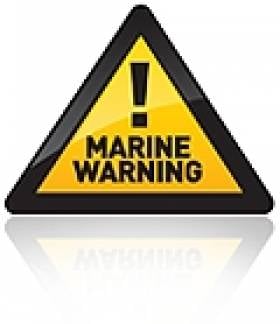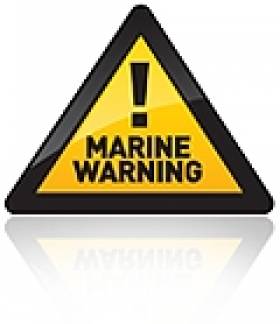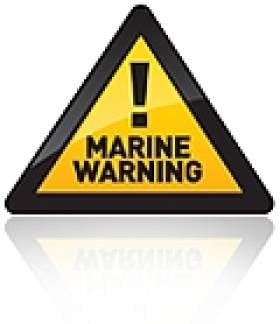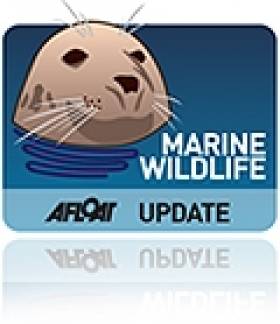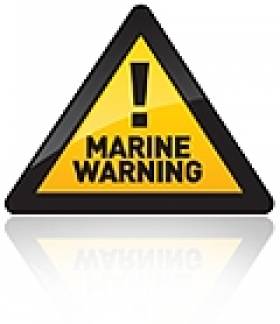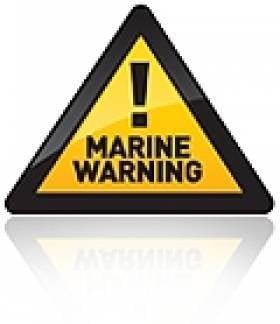Displaying items by tag: Corrib Gas field
#MarineNotice - Marine Notice No 15 of 2013 from the Department of Transport, Tourism and Sport (DTTAS) advises mariners that a hydrographic and geophysical survey operation is being undertaken by INFOMAR for the Sustainable Energy Authority of Ireland till 25 April.
The RV Celtic Voyager (Call sign EIQN) is carrying out the survey operations within an area bounded by co-ordinates included in the notice, available as a PDF to read or download HERE.
The vessel is towing a magnetometer sensor with a single cable of up to 100m in length. It is also displaying appropriate lights and markers, and will listen in on VHF Channel 16 throughout the project.
Meanwhile, Marine Notice No 16 of 2013 advises that Shell E&P Ireland is deploying a Waverider buoy off northwest Co Mayo to help predict sea conditions for the laying of an offshore umbilical to the Corrib Gas Field later this year.
The buoy is yellow in colour and will flash yellow five times every 20 seconds. The notice includes an image of what the buoy looks like in the water, as well as the co-ordinates of its placement.
All vessels are requested to give the wave buoy a wide berth.
Marine Notice: Offshore Trenching Works At Corrib Gas Field
#MarineNotice - Marine Notice No 9 of 2013 advise of preparatory works for the installation of an offshore umbilical at the Corrib Gas Field development off Co Mayo.
Works are set to commence in early March along the route of the existing Corrib offshore gas pipeline with a route survey and pre-cut trenching by the Normand Ranger (Call sign LAMT).
A trench will be constructed from the subsea facilities and well in the Corrib Gas Field to approximately 16km offshore using a subsea plough pulled by the trenching support vessel.
This plough could trail as far as 1,700m behind the support vessel, and so all vessels in the vicinity are requested to keep a wide berth clear of the works. All vessel involved in the operations will be listening on VHF Channel 16 throughout the project.
Full details including relevant co-ordinates are included in the Marine Notice, a PDF of which is available to read or download HERE.
Marine Notice: Corrib Field Seismic Survey Set to Recommence
#MarineNotice - The latest Marine Notice from the DTTAS concerns the scheduled recommencing of a 3D seismic survey over the Corrib Gas Field by Shell E&P Ireland Ltd.
Some 40% of the survey was completed in 2012, and the remaining 60% is now set to be conducted with a planned starting date of 20 February 2013. Weather permitting, the survey should be completed in June 2013.
The seismic acquisition will comprise a four-boat operation. The M/V Ocean Pearl (Call sign C6ZW4) will lay the ocean-bottom cables on the sea floor and will collect all data records, while the M/V Malene Ostervold (Call sign LCIU3) will serve as the source vessel. In addition to these vessels, a third vessel, the M/V Vikland (Call sign C6UL5) will assist the M/V Ocean Pearl with cable laying and also act as a utility vessel. A fourth vessel, the M/T Deilginis (Call sign EISL), will act as a guard wessel.
Seismic acquisition will occur over a set of four active 12km-long solid ocean-bottom cables laid 400m apart on the sea bed at a depth of 350m. At the end of each cable is a 1km lead-in section which is attached to a standalone buoy at surface. These buoys contain a power pack as well as a recording system. Each buoy contains a radio-link with the cable-laying vessel for remote control of the buoy and for data quality control. Each buoy has a GPS receiver, so its location is well known to both seismic vessels. One by one these cables are 'rolled along' (ie picked up from the northern edge of the active spread, and redeployed at the southern edge). The M/V Malene Ostervold will be towing two seismic sources, and operating around the set of four active 12km-long cables.
The overall survey area is divided into three work areas or Contact Zones (A, B and C). A Contact Zone is defined by a 10km radius circle. Radio Navigation Warnings will be given out daily by the Irish Coast Guard, giving the co-ordinates of the centre point of the Contact Zone for that day. All vessels will be listening on VHF Channel 16 throughout the project.
Full details - including co-ordinates and maps of the survey area - are contained in Marine Notice No 07 of 2013, a PDF of which is available to read or download HERE.
Marine Notice: Rock Installation Works Along Corrib Pipeline
#MARINE WARNING - The Department of Transport, Tourism and Sport (DTTAS) has been advised that subsea rock installation works will shortly commence along a pipeline route from the Corrib Gas Field in Broad Haven Bay off Co Mayo.
Works will commence in the middle of this month (October 2012) and are expected to be completed in 6-10 days. The operation will be carried out by the vessel Tertnes (Call sign PGAN). All vessels in the vicinity are requested to keep clear of the works as these works progress along the pipeline route and to comply with requests from work vessel.
Furthermore, all vessels are requested to monitor and comply with the Radio Navigational Warnings that will be broadcast for the duration of the works. All vessels involved in the operations will be listening on VHF Channel 16 throughout the project. All vessels are required to comply fully with the International Regulations for the Prevention of Collisions at Sea and to manoeuvre their vessels accordingly.
The attention of all is also drawn to Marine Notice No 17 of 2007, which gives general advice in relation to the activities of vessels engaged in survey work for hydrographic, seismic, fishing research and underwater operations.
Full details of co-ordinates for the current works are included in Marine Notice No 57 of 2012, a PDF of which is available to read or download HERE.
Corrib Pipeline Tunnel Machine Removed from Mayo Road
#COASTAL NOTES - A tunnel boring machine destined for work on the Corrib Gas Field project that became stuck at a country crossroads in Co Mayo for much of last week has been removed, as The Irish Times reports.
Shell E&P Ireland apologised to the local community and any road users "who were inconvenienced by this incident" after the truck carrying the giant machine jack-knifed at the isolated road junction on Tuesday 31 July.
The truck was one of four headed to the Sruwaddacon estuary in north Mayo for construction work on what will be the longest raw gas undersea tunnel in Western Europe, used to link the Corrib pipeline to the on-shore refinery at Bellanaboy.
It was finally removed from the crossroads on Friday 3 August.
A spokesman for Rossport Solidarity Camp added that veteran anti-Corrib campaigner Maura Harrington was arrested at one of the Garda checkpoints around the stricken vehicle some 10km away at Bangor Erris.
As previously reported on Afloat.ie, the controversial gas field project has come under much criticism from locals, activist groups and political parties for various issues.
In March last year, former Minister for Energy Pat Carey was rebuked for granting key consents for the Corrib gas pipeline on the day of the general election, despite planning only being approved by An Bord Pleanala with 58 conditions related to the construction and management of the 8.3km pipeline.
Earlier this summer the Irish Whale and Dolphin Group (IWDG) claimed the Department of Energy could be in breach of the EU habitats directive for licencing a seismic survey related to the project without providing adequate protection for marine wildlife.
And in June a Scandinavian economist who met residents in north Mayo told The Irish Times that the Norwegian people have "no idea of what's being done in their name" via the role of state oil firm Statoil in the Corrib Gas Field.
#COASTAL NOTES - The Norwegian people have “no idea of what’s being done in their name” at the Corrib Gas Field, a Scandinavian economist has told The Irish Times.
Bjørnar Nicolaisen was speaking on the role of Norwegian firm Statoil in the controversial project, following his visit with residents in North Mayo on the invitation of community mediation group Pobal Chill Chomáin.
The fisherman-turned-economist also echoed concerns regarding the impact on marine wildlife in the area by the seismic surveying currently being carried out on the gas field.
As previously reported on Afloat.ie, the Irish Whale and Dolphin Group (IWDG) has lodged a complaint with the European Commission and the Department of Energy, indicating that the department could be in breach of the EU habitats directive for licensing the seismic survey without providing adequate protection for aquatic wildlife in an area that is part of Ireland's coast-wide whale and dolphin sanctuary.
Calls have also come for a safety review of the project's infrastructure after Ireland's biggest earthquake in years struck just 23km from the Corrib field earlier this month.
Meanwhile, Statoil spokesman Bård Glad Pedersen told The Irish Times that the company believes “it is possible to conduct seismic surveys and develop oil and gas projects while protecting fisheries”.
#EARTHQUAKE - The North West region experienced its biggest ever earthquake this week in an event that poses “very interesting questions for geologists”.
The magnitude 4 quake on the morning of Wednesday 6 June, which was epicentred close to the Corrib Gas Field off the coast of Co Mayo, resulted in tremors felt from Sligo to Galway and numerous reports of houses shaking, as The Irish Times reports.
Minister for Energy and Natural Resouces Pat Rabbitte said all evidence pointed to the incident being a “naturally occurring earthquake” and emphasised there was “no link” to works on the Corrib field.
Experts from the British Geological Survey said it was "not a warning of anything bigger to come".
However, Tom Blake of the Irish National Seismic Network (INSN) said that the "moderate" quake was “significant” in that it challenged existing information about seismic activity in the region.
Shell EP Ireland said the seismic survey had not started and it had “no reason to believe that this event has had any impact on the sub-sea infrastructure”.
“However, as a precautionary measure, a visual inspection of the offshore infrastructure will be carried out in the coming days,” it said.
Ireland's biggest earthquake on record was in 1984, when a magnitude 5.4 quake struck off Wales, causing some structural damage along the east coast.
#MARINE WILDLIFE - The Department of Energy could be in beach of the EU habitats directive for licensing a seismic survey off the West coast without providing adequate protection for marine wildlife.
As The Irish Times reports, the Irish Whale and Dolphin Group (IWDG) has lodged a complaint with the European Commission and the Department of Energy over the survey licence.
Shell E&P Ireland Limited is scheduled to carry out the 3D seismic survey over the Corrib Gas Field off Co Mayo from today 1 June, as previously reported on Afloat.ie. Weather permitting, the survey would be completed around the middle of September.
The waters around Ireland are designated as a whale and dolphin sanctuary. According to the IWDG, 21 cetacean species have been recorded off the Mayo coast, including endangered species such as the northern right whale, fin whale and humpback whale.
Under the EU habitats directive, member states are mandated to establish strict protections for marine wildlife, which includes prohibiting “deliberate disturbance... particularly during the period of breeding, rearing, hibernation and migration”.
The Irish Times has more on the story HERE.
Marine Notice: Well Inspections on Corrib Gas Field in May
#MARINE WARNING - Further to the notice earlier this week of a seismic survey over the Corrib Gas Field, the latest Marine Notice from the Department of Transport, Tourism and Sport (DTTAS) advises of well inspections in the area next month.
The survey vessel Well Enhancer (call sign 2ARS4) will be on location for approximately 30 days from next Thursday 3 May 2012. It will be listening on VHF Channel 16 throughout.
All mariners, including those engaged in fishing, are requested to give the vessel a wide berth of at least 500 metres and to keep a sharp lookout in the relevant areas. Mariners are also reminded of the 'safety zone' in place around the Corrib Gas Field as referred to in Marine Notice No 21 of 2006.
Complete details including co-ordinates of the work area are included in Marine Notice No 21 of 2012, a PDF of which is available to read and download HERE. Mariners are advised to check for amendments to this notice in the event of any significant changes to either location or duration.
#MARINE WARNING - Shell E&P Ireland Limited is scheduled to carry out a 3D seismic survey off the west coast of Ireland over the Corrib Gas Field.
The planned start date of the survey is 1 June 2012 and, weather permitting, the survey should be completed around the middle of September 2012.
The seismic acquisition will comprise a two-boat operation; the M/V Ocean Pearl (call sign: LAGD6) will lay the ocean bottom cables on the seafloor and will collect all data records, while the M/V Malene Ostervold (call sign: LCIU3) will serve as the source vessel. In addition to the seismic vessels, a third vessel will act as a guard vessel.
Seismic acquisition will occur over a set of six active 12km long solid ocean bottom cables laid 400m apart on the sea bed at a depth of 350m by the M/V Ocean Pearl. At the end of each cable is a 1km lead-in section which is attached to a standalone buoy at surface. These buoys contain a power pack as well as a recording system.
Each buoy contains a radio-link with the cable-laying vessel for remote control of the buoy and for data quality control. Each buoy has a GPS receiver, so its location is well known to both seismic vessels. One by one these cables are 'rolled along', ie picked up from the northern edge of the active spread, and redeployed at the southern edge.
The M/V Malene Ostervold will be towing two seismic sources, and operating around the set of six active 12km long cables.
Radio navigation warnings will be given out daily by the Irish Coast Guard, giving the co-ordinates of the centre point of the working area for that day. All vessels will be listening on VHF Channel 16 throughout the project.
All vessels, particularly those engaged in fishing, are requested to give the seismic vessels a wide berth and keep a sharp lookout in the relevant areas.
Complete details including co-ordinates of the work area are included in Marine Notice No 17 of 2012, a PDF of which is available to read and download HERE.


























